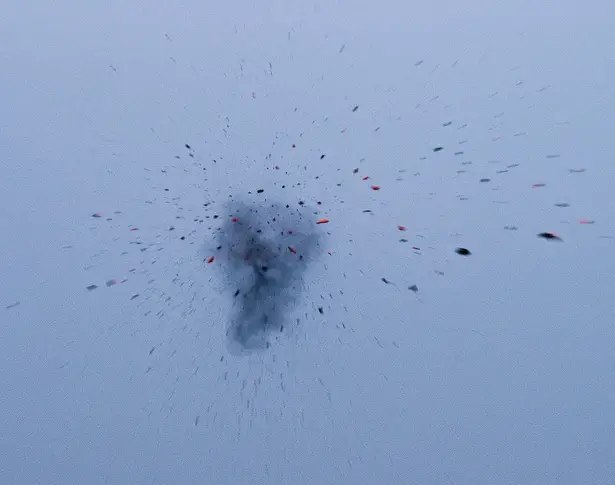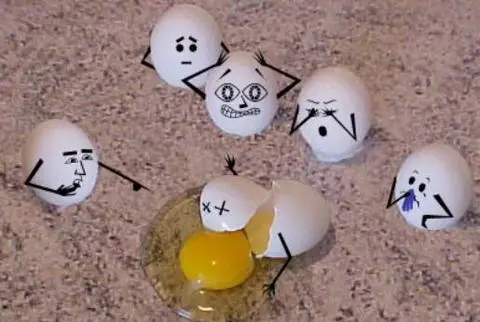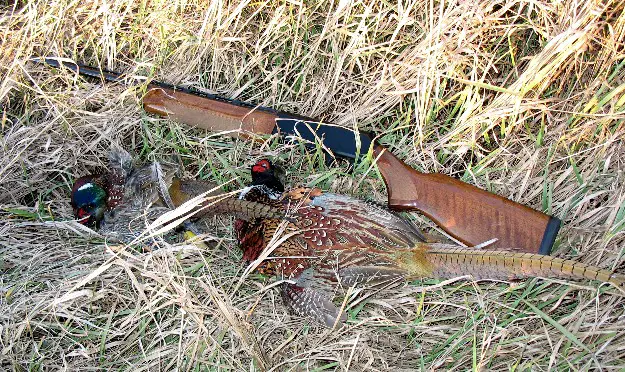


Shotshell Gauges, Payloads, and Velocity: Cutting Through the Bull

What gauge, what payload,
what shotsize, what choke, what range? How many hits? Only photographer
Paul Kavanagh, owner of http://www.learningtosnap.com , might be able to answer a few of these
questions. My thanks to Paul for allowing his photograph to appear here.
Paul shot this using ISO-400 film: a tougher shot with a camera than it
is with a shotgun, to be sure.
It is human nature to avoid logic and facts. Often, we embrace the silliest of notions when it comes to the basics of shotshell performance. We don't want math to work, but unfortunately it does.
Clayshooters in particular are susceptible to the strangest of notions. One of the most ridiculous notions is “reading breaks.” Sure, breaking clay pigeons is more fun than patterning our guns and different ranges, a lot more fun. Patterning guns has meaning, reading the way a clay pigeon crumbles does not. Shooting a round of skeet with a buddy of mine, half way through the round one of the other shooters commented, “Oh, I know what you are doing.” Aside from walking around the skeet field like everyone else, I had no idea where that one was coming from. He continued, “You're choking way too heavy for skeet. Those birds are breaking too hard, you're using full choke. You shouldn't have ink blots like that.” Like most self-appointed technical observers, he had little clue. The gun was a Browning B-80 20 gauge and the “mystery choke” that stunned our little clay-break reader was a factory Invector “Cylinder” tube.
We place ourselves at a distinct disadvantage at clays and in the field when we use overly light payloads. Common sense should tell us that we cannot possibly have more pellets in our effective pattern at range than leaves the muzzle in the first place. We don't. One of two things must happen. We have a pattern of the same size that is overly thin and ineffectual with a lighter payload, or we have a smaller pattern of the same density. We try to rationalize this away as best we can, but we still can't get away from the math.
We try to say, “If we are on the bird it breaks, regardless.” It can happen, of course, but we unnecessarily lower the probability of it. We have all heard, or used the line that “lighter loads pattern better.” Not always true, but it is more true than not if we just mean percentage. Few people agree what “better” actually is. If by “better” we mean a higher percentage of pellets in a circle at 40 yards, well-- we would always shoot high constriction chokes, the tightest constriction choke we could possibly find until pattern percentages ceased to increase. We don't do that all the time, though, as we know that it shrinks our effective pattern size at shorter ranges significantly.

You just can't count on a laugh everytime you crack a yolk. More to the point, reading a break means nothing in particular.
How often have you heard that a particular shotgun, a shell, or a choke tube “crushes clays”? If there is one chuckleheaded notion, that is probably it. All we have to do is read the box clay pigeons come in to find “WARNING: “Extremely fragile.” Or, “Fragile Like Eggs.” Just because a shotgun blowing hundreds of pellets out of the muzzle can actually shatter something that is extremely fragile in the first place is hardly worthy of comment, much less bragging rights. It makes no sense.
Even if pattern percentages drop by 3-5% or so with a heavier payload, the math doesn't work. We can throw 1 oz. of lead at a pheasant with a 65% pattern, or we can throw 1-1/4 oz. of lead at a pheasant with a 60% pattern. It still means .65 oz. versus .75 oz. Even assuming the percentage loss, we would still ignore a 15% net gain in pattern population with our 1-1/4 oz. load.
Still we struggle to rationalize. “Hey, I dropped to 1 oz. loads today from my 1-1/8 oz. loads and my scores went up!” Perhaps our scores did go up, but it wasn't due to the lighter payload. Scores go up when we shoot better, simple as that.
We play the same mental gymnastics when it comes to brand of guns. “I see more Z than P guns. Ozzie won the championships with a BenChester.” Brand of the gun has little to do with it. It is this type of third-grade psychology that lead to the “Choosey Mothers Choose Jif” slogan. Evil mothers of course torture and abuse their kids by forcing Skippy down their innocent throats. What about Peter Pan? I haven't seen any of the good shooters eating it, lately. Serious shooters use Reese's, anyway. It is the old “safety in numbers” and “what's the other guy doing” nonsense all over again. Rather than coming to reasonable, well-founded, rational conclusions we would rather cop-out to who is on the Wheaties box, who the Lithuanian Gold Cup, or what sells the most. It is all part of the human condition. MacDonald's sold billions of hamburgers, so you just know they have to be fabulous. We don't need Mr. Spock or any other Vulcan to tell us this isn't logical.
There is a very good reason to drop payload and velocity, though, the omnipresent recoil factor. We really goof ourselves up with recoil. Some of the bad habits are so bad, some of us end up using release triggers. If we grow dependent on release triggers for proper trigger timing, we have little chance of ever learning how to properly use a regular trigger ever again. Far too many folks have found that out the hard way.
Pellets drop targets and bag birds, not percentages, and certainly not gauges. It isn't a matter of debate at all (unless we choose to debate over nothing), it is a well-settled matter. Whether the pellets come out of a 28 gauge or a 10 gauge, it doesn't matter to a game bird. The pattern that can be achieved is based on payload, not bore diameter. Limitations of a gauge in the field coincide with the limitations of payload.

Two thousand four hundred mallards donated their lives to science to show that #4 shot is clearly more effective than #6 shot at all ranges 35 yards and beyond, regardless of gauge.
Right now, 1 oz. payloads are available in 28 gauge in Winchester AA 1205 fps loads. There isn't a 28 gauge I've tried with them that cannot produce a more effective pattern with them than the more common 3/4 ounce loads. Still, you will hear that a heavy load such as this "doesn't pattern as well" as a standard load. It only tells me that they haven't been tried. Regardless of how you view it, there is still that 3/4 ounce load sitting right on top of that 1 ounce load. The conversation often continues, “But why would you want to?” The answer is that we might have a 28 gauge that fits us superbly well, we love hunting with it, so we want to hunt with it as much as possible. Just because we enjoy the way a gun carries and shoulders doesn't mean we want cripples. To that end, particularly when the bird happens to be a pheasant with far more walking than shots fired, 1 oz. of #6 shot out of our favorite 28 gauge out to thirty yards with the right choke might be ideal. That load, perfectly centered with a full choke, is a 99.3 percent killer at thirty yards out of a 20 gauge. This is all well-documented information, based on 2,400 game farm mallard kills from Winchester. What some folks might find surprising is that at 35 yards (and beyond), regardless of 20, 16, or 12 gauge, #4 shot invariably outperformed #6 shot in lethality.
So it goes regardless of gauge, regardless of game. There is no substitute for appropriate payload and shot size. Even Bob Brister, in his must read “Shotgunning: The Art and the Science” was happy to recommend 1-1/4 oz., #7-1/2 hard shot, full-choked pigeon loads for jump-shooting doves. The expensive, extensive Winchester testing was a long, long way to go to clearly show that “more is more” and “larger is larger” but that was the result of it.
We also have peculiar ways of referring to gauges. Anything under a 12 gauge is deemed a “sub-gauge.” With that type of illogic, the puny .30-06 would certainly be a “sub-bore” or a “sub-caliber.” It is, compared to the U.S. Military standard issue .45-70 Government that long preceded it. You'll likely never hear a reference like that, though, as judging a firearm by what it can actually do rather than by its dimensions is a far more thoughtful approach.
The lingering gauge goofiness is understandable, though. We still have “dram equivalents” on shotshell boxes that mean nothing specific. We have code words for lead shot that strive to avoid what it is, like “hard shot.” Hard lead is something like stiff jello. It is hardly hard, but calling it hard is a lot more convenient than actually having to state its actual Brinell hardness or antimony content. “Magnum Shot” is even a more nonsensical term. Magnum of course means “large” but “magnum #7-1/2” shot is no larger than any other #7-1/2 shot.

Words don't always mean things. Like "Jumbo Shrimp," the Magnum Mini is either big little one or a rare, very small form of a large one. The difference in size between "magnum" and regular lead shot will likely remain an eternal mystery.
We inherited the notions of gauge. The general idea of what a gauge does goes back to historic loadings normally offered by gauge. 28 is a 3/4 ounce load, 20 is 7/8 oz., 16 a 1 ounce, and 12 gauge a 1-1/8 oz. payload. Nothing wrong with history, it is good to know where things come from. It isn't representative of current shotshell construction, current propellants, current shot materials, or current chamber lengths. One example would be the 1-1/2 oz. Federal Heavyweight #7 20 gauge load that blows the lid off of any hoary ideas of 20 gauge performance. A factory load like this was inconceivable a decade ago, yet with it a 20 gauge outperforms any 2-3/4 inch lead 12 gauge shotshell ever loaded.
Today, the limitation of the gauge is primarily case capacity. The shootability of a shotgun, irrespective of gauge, is the same as always. It is largely a matter of gun weight, stock fit, and the number of times we are going to use that load within a certain time frame, with our type of clothing, etc., also playing a role.
There aren't many rules when it comes to the mysteries of shotgun patterns. There are generalizations, though. Once you go much beyond the 1300 fps area, patterns degrade. It is as close to a universal truth as there is. With lead, even the “buffered really stiff lead” there is still some deformation on initial setback. With steel and other hard shot materials, you still have pattern degradation. Not by deformation of the shot, but by the chaotic collision inflicted by choke, the billiard ball effect. Regardless of shot type, extremely high relative velocity invariably opens up and tends to degrade patterns.
As a practical matter, cost rears its head. We like to grouse about the cost of 28 gauge shells and the lack of wide variety of 16 gauge loads as well. What we say we really want and what we actually end up buying are often two different things. Some of this is a great pity, as perhaps the most useful upland gauge of all, the 16 gauge, has faded from topical load development, leaving many folks to just hold their noses and buy a 12 gauge, regardless. Or hold their noses a lot less and use a 20.
We all like to be able to consider what is new and that also means 12 gauge as of late. It wasn't always so, as the Winchester Model 12 was first offered in 20 gauge, as was the Remington Model 17, the precursor of the Ithaca Model 37. The Winchester Model 21 was the shotgun that introduced the 3-inch 20 gauge to the public in 1954. Unless things change, unlikely in the ultra-conservative shotgun market, the greatest opportunity for load advancement currently rests with the 20 gauge. We have already seen it in 20 gauge slug guns, like Savage's blisteringly accurate 220F, and we have seen it with shotshells like Federal's Heavyweight offerings. The Rodney Dangerfield of shotshells, the 3-inch 20, is finally getting some of the respect it deserves.
It is part of the human condition that makes us want to constantly reverse things. Like the fellow that keeps the thermostat at 68 degrees in summer, but 82 degrees in winter, we like to change things often just because we can. So it goes with shotguns. We want 28 gauge and 20 gauge light loads to cycle our 3-1/2 inch 12 gauge autoloaders and we also want our 12 gauges as light as 20 gauges as well. Then, of course, we carp when our featherweight 12 gauges aren't comfortable to shoot, opting to put pieces that look like they fell off an old accordion or perhaps the Michelin Man on the buttstocks of our perky twelves. It's all good fun.
What we are doing, in large measure, is constantly underestimating the 20 gauge and overestimating the 12. The fundamentals of payload and velocity, and the effective patterns they can produce based on those two qualities alone are hard to get away from. We will keep on striving, though.
There is no automatic difference between a 1 oz. load out of a 20, 16, or 12 gauge. Not a little-- none. Far more important is shot quality, shell quality, barrel quality, choke quality, the way a gun fits and swings for us and so forth. Gauge doesn't matter just a little bit; it does not matter at all. Top shooters at American skeet are at a statistical dead heat regardless of 12, 20, or 28 gauge. There are differences, even at these short ranges, but it isn't gauge-related. The 28 is restricted to a 3/4 oz. payload, the 20 to 7/8 oz. The 12 gauge class allows 1-1/8 oz. This isn't part of the difference, it is all of the difference. No shotgun ever made can form a pattern with more pellets than were spewed from the muzzle in the first place.
Payload does matter. In the case of Helice and Box Pigeon, a typical load is 1-1/4 oz. of #7-1/2 shot at 1330 fps. It does point squarely to 12 gauge only, but not due soley to a narrow view of the gauge. That payload and velocity is not typically available in smaller gauges in target loads. Nor is the lighter weight of smaller bore frames considered a particularly pleasant platform for constant use of this payload even if it were.
The fundamentals have nothing to do with a gauge or the unfolded length of a shotshell; they never did and they do not today. We need enough pellet density in our pattern at the range of our target to assure virtually a 100 % chance of a 2 - 3 pellet hit in the critical zone. We need the pellets to retain enough mass and velocity (not diameter) at that range to ensure adequate penetration to reach and destroy vital organs. That's essentially all there is, aside from actually being aware of the range and placing that pattern on our target.

Copyright 2010 by Randy Wakeman. All Rights Reserved.




